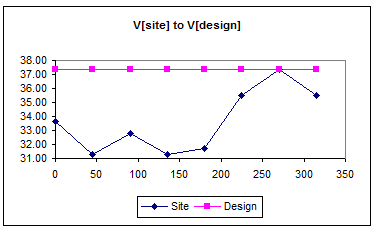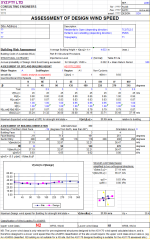schWindAssessment

Description
Assessment of design wind speed to AS1170.2:2002, and assignment of AS4055 wind classification. Wind assessed in all 8 cardinal directions, then simplified to 2 orthogonal directions. Shows graph of variation in site and design wind speed with direction. Could be modified for use with ASCE07 by replacing multipliers M with K values, and adjusting. Noting ASCE applies to wind pressure whilst AS1170 applies to wind speed.
Calculation Reference
Wind design
Calculation Preview
Full download access to any calculation is available to users with a paid or awarded subscription (XLC Pro).
Subscriptions are free to contributors to the site, alternatively they can be purchased.
Click here for information on subscriptions.
Comments: 4
×
15 years ago
New version uploaded. It is now better able to consider the 8 cardinal directions and calculate the 4 orthogonal directions for a building at a known orientation. An Excel chart is also used to illustrate the orientation of the building relative to the cardinal axes.
A new version of schTechLib required, for the functions which deal with the wind quadrants.
regards
Conrad
A new version of schTechLib required, for the functions which deal with the wind quadrants.
regards
Conrad
16 years ago
Note this workbook requires the following additional workbooks:
AS4055.xls: this is used to lookup the wind class
schTechLIB.xls /xla : this contains functions to interpolate the AS1170.2 tables for M[z,cat], Ms, Mt
It also contains functions for obtaining and interpolating Cpe for enclosed buildings and canopies. The functions for direction theta=90, can find a Cpe value for any frame along the length of the building. So can extend this workbook to get the pressure coefficients for a given building, and then combine with the Kleinlogel workbook, or beam design workbooks, to design a complete structure.
To calculate a value for shielding Ms, use DvdHntr's Wind Actions workbook, which only considers the wind from one direction. Personally don't see much value in shielding and always adopt Ms=1, unless doing residential and have to match a wind speed map class. Take a typical street. Then along that street, houses probaly have full shielding (FS), across the back fence between gardens with sheds and verandahs around probably got partial shielding (PS), and across wide streets no fencing getting a lot closer to no shielding (NS). If only adopt a single design wind speed for the site then the NS condition controls. If choose 2 orthographic directions then may gain some benefit. But then new houses typically built in locations where the terrain changes with direction. So then have controlling condition of say TC2.5 in one direction, spreading out into rural territory, with TC3 in another direction the established suburban terrain be expanded.
Hence reason the code requires consideration of 8 cardinal directions. The report on damage after cyclone Larry, indicates a high incidence of poor assesment of wind loading. Drawing the 1000m terrain averaging distance on a street map, and assessing terrain, topography and shielding in all directions would be a good start to improving the assessments.
AS4055.xls: this is used to lookup the wind class
schTechLIB.xls /xla : this contains functions to interpolate the AS1170.2 tables for M[z,cat], Ms, Mt
It also contains functions for obtaining and interpolating Cpe for enclosed buildings and canopies. The functions for direction theta=90, can find a Cpe value for any frame along the length of the building. So can extend this workbook to get the pressure coefficients for a given building, and then combine with the Kleinlogel workbook, or beam design workbooks, to design a complete structure.
To calculate a value for shielding Ms, use DvdHntr's Wind Actions workbook, which only considers the wind from one direction. Personally don't see much value in shielding and always adopt Ms=1, unless doing residential and have to match a wind speed map class. Take a typical street. Then along that street, houses probaly have full shielding (FS), across the back fence between gardens with sheds and verandahs around probably got partial shielding (PS), and across wide streets no fencing getting a lot closer to no shielding (NS). If only adopt a single design wind speed for the site then the NS condition controls. If choose 2 orthographic directions then may gain some benefit. But then new houses typically built in locations where the terrain changes with direction. So then have controlling condition of say TC2.5 in one direction, spreading out into rural territory, with TC3 in another direction the established suburban terrain be expanded.
Hence reason the code requires consideration of 8 cardinal directions. The report on damage after cyclone Larry, indicates a high incidence of poor assesment of wind loading. Drawing the 1000m terrain averaging distance on a street map, and assessing terrain, topography and shielding in all directions would be a good start to improving the assessments.



http://miscion.com.au/setting-up-spreadsheet-environment/